Patient Ombudsman 2022/23
Guiding with Purpose
Fairness at every step
Patient Ombudsman’s message
The 2022/23 operating year was one where patients, residents, caregivers, and health care providers continued to experience challenges.

Patient Ombudsman’s message
The 2022/23 operating year was one where patients, residents, caregivers, and health care providers continued to experience challenges; some due to the lingering effects of the pandemic and others more systemic in nature that pre-date the pandemic. This office also experienced challenges such as increasing numbers of complaints, changes to legislation and a growing need to support patients, residents and caregivers who have nowhere else to turn.
Since opening in 2016, we have been listening and learning from the complaints people have brought to our office. These complaints provide our health care system with an important source of insight as to what is working and, more importantly, what is not. By responding to thousands of complaints, this office has gathered a growing body of knowledge, resources, patient/resident stories and data to share with the health sector to support a more proactive approach to addressing concerns before they give rise to complaints.
Nowhere to Turn
In 2022/23, we received more than 4,300 complaints. This is our highest number of complaints to date and represents a 33% increase in complaints over the previous year.
What is notable, and troubling, is the significant growth in non-jurisdictional complaints that are mostly related to primary care and echo some all-too-familiar themes: people are having trouble accessing primary care, have limited options for their care, and often have nowhere to turn.
These non-jurisdictional complaints highlight a significant and growing need being met by this office: system navigation. In addition to closing a record number of complaints last year, our Early Resolution Specialists helped connect thousands of complainants with hospital patient relations staff, other organizations or services that could assist with their concerns and made hundreds of referrals to regulatory colleges, ensuring patients, residents and caregivers had the information and support they needed.
Anticipating the Challenges
This past year, the More Beds, Better Care Act, 2022 came into effect, resulting in significant changes to long-term care placement processes for hospital patients who have been deemed to require an alternate level of care. In anticipation of these changes, we released our first Fairness by Design resource, which aims to help hospitals and Home and Community Care Support Service organizations proactively review the fairness of their processes and decision-making. This resource represents an important tenet of ombuds work: incorporate fairness at the outset of developing policies and procedures to proactively address concerns.
Sharing Knowledge and Insight
Our investigation work also helps facilitate a more proactive approach to managing challenges in the health care system. Last year, we undertook three investigations and publicly released investigation summaries related to billing for uninsured services, the chronic care co-payment, and reprisal and access to care. These summaries outline the recommendations we made and serve as important resources to health organizations looking to review their own processes.
Strengthening Complaints Processes
Near the end of the 2022/23 operating year, we learned that our jurisdiction would be expanding to include community surgical and diagnostic centres (formerly known as independent health facilities). In February 2023, the provincial government introduced the Your Health Act, 2023, which would regulate community surgical and diagnostic centres that can provide publicly funded diagnostic and imaging services, as well as some low-risk surgical procedures. Since the Act came into force in September 2023, Patient Ombudsman’s jurisdiction now includes community surgical and diagnostic centres. In the coming year, we will engage with this sector to ensure providers are familiar with Patient Ombudsman processes and will support patients in addressing their concerns.
Evolving to Meet the Need
Given how quickly things change in health care, it’s important for this office to continue adapting and adjusting how we work to ensure we’re meeting the needs of patients, residents, caregivers, as well as the health organizations and providers that serve them.
None of this would be possible without the hard work of a talented team who are passionately dedicated to ensuring patients and residents have fair and equitable health care experiences. We don't mind the growing number of complaints. In fact, it’s a sign of a healthy system. When people make complaints, it shows they are comfortable talking about what isn’t working, and it provides a second chance to make things right for the complainant and hopefully ensure it doesn’t happen to anyone else.
I encourage patients, residents and caregivers, and even health care providers and health sector organizations to continue reaching out to our office with their concerns. We know it can be difficult to speak out when you’ve had or been part of a negative experience – but it’s the best way to ensure better experiences for everyone.
Sincerely,
Craig Thompson,
Patient Ombudsman
What Patient Ombudsman does
We champion fairness for everyone, and work to ensure more positive health care experiences for all Ontarians.
About our office
What is an ombuds?
An ombudsman (ombuds or ombudsperson) helps resolve complaints and identifies issues in an independent, impartial and confidential manner. Ombuds offices have a mandate to ensure people are treated fairly by public bodies; to promote fairness and accountability in public administration; and to provide independent and impartial oversight of public services.
To fulfil our mandate, Patient Ombudsman upholds the principles of an ombudsman office as set out in the Statement of Ethical Principles of the Forum of Canadian Ombudsman and the Venice Principles, an internationally accepted set of standards that set out the fundamental principles essential establishing an independent and impartial ombudsman institution.
Patient Ombudsman
As set out in the Excellent Care for All Act, 2010, Patient Ombudsman’s role is to help resolve complaints from patients, residents and caregivers about their experiences in Ontario’s public hospitals, long-term care homes, and home and community care.
Patient Ombudsman can also undertake investigations, either from complaints or as an own motion investigation that looks into systemic issues that come to Patient Ombudsman’s attention as the result of trends in complaints or as a matter of high public interest.
As an office of last resort, Patient Ombudsman can help when patients, residents and caregivers have not been able to resolve their complaint directly through the health care organization’s internal complaints process. Patient Ombudsman believes that resolutions are best achieved as close as possible to the point of care and will often reconnect complainants with the appropriate person in the organization if the complaint is premature.
Some matters may be outside of Patient Ombudsman’s jurisdiction. We cannot address complaints about compliance with professional standards by regulated health professionals (e.g., doctors or nurses); about organizations that are not under our oversight (such as a walk-in clinic or retirement home); or if the complaint is part of another proceeding (such as, a lawsuit or coroner’s inquest). When we cannot attempt a resolution of a complaint, we can often direct patients, residents and caregivers to someone who can help.
When working to resolve a complaint, Patient Ombudsman uses the ‘Fairness Triangle’ as a framework for our review. The Fairness Triangle outlines a set of principles that can be used when analyzing a complaint and to test if a resolution is fair – it looks at what the health sector organization decided, how was it decided, and how people were treated and helps us consider issues from all perspectives.
2022/23 at a glance
More help for more people
Patient Ombudsman received 4,388 complaints between April 2022 and March 2023, 33% more complaints than were received in 2021/22.
New complaints in 2022/23 exceeded the previous annual high (which occurred in the first year of the COVID-19 pandemic) by almost 800 complaints.
Year over year growth in complaints
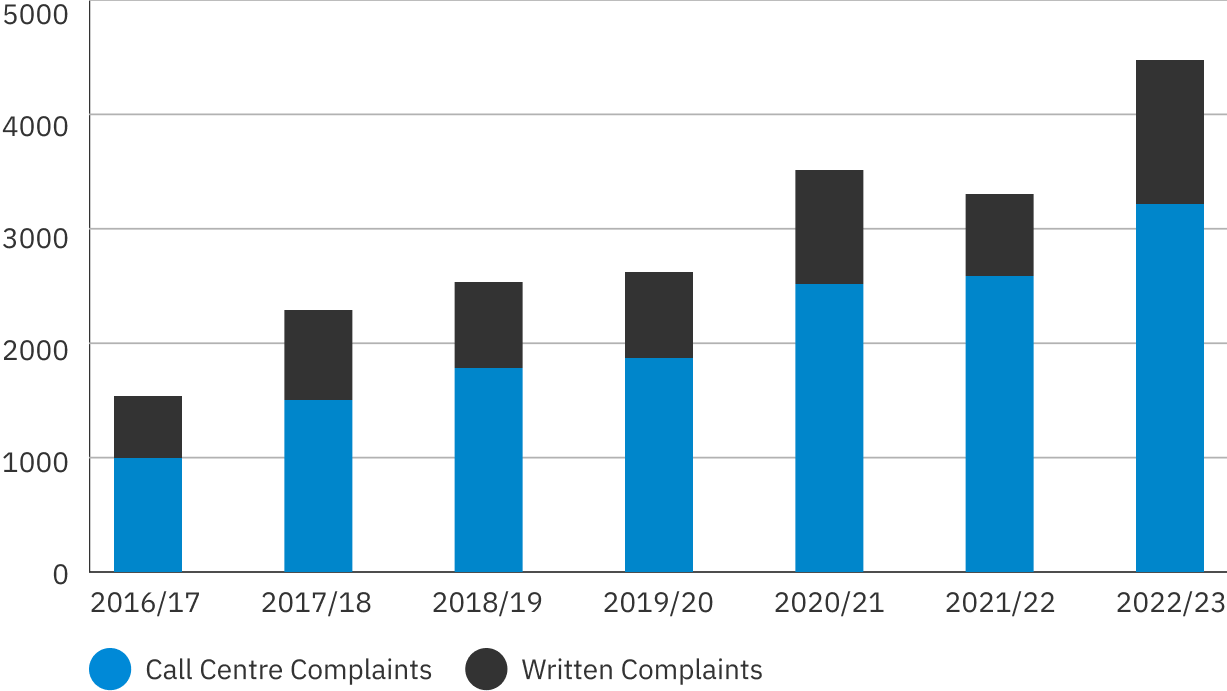
Patient Ombudsman received 3,235 complaints through the call centre and 1,153 written complaints. Some people submitted multiple complaints over the year, including 180 who initially contacted the call centre and later followed up with a written complaint. Five per cent of the complaints described concerns with more than one health care organization or provider, and complaints frequently involved multiple issues. It’s not unusual for individual complaints to include some issues within Patient’s Ombudsman’s jurisdiction and others that are either premature for our involvement or are subject to oversight by other agencies.
Of the 2,867 complaints about health sector organizations within Patient Ombudsman’s jurisdiction, 652 included matters that are within the oversight of health professions regulatory colleges or other complaints agencies or processes.
4,388 total complaints to Patient Ombudsman in 2022/23
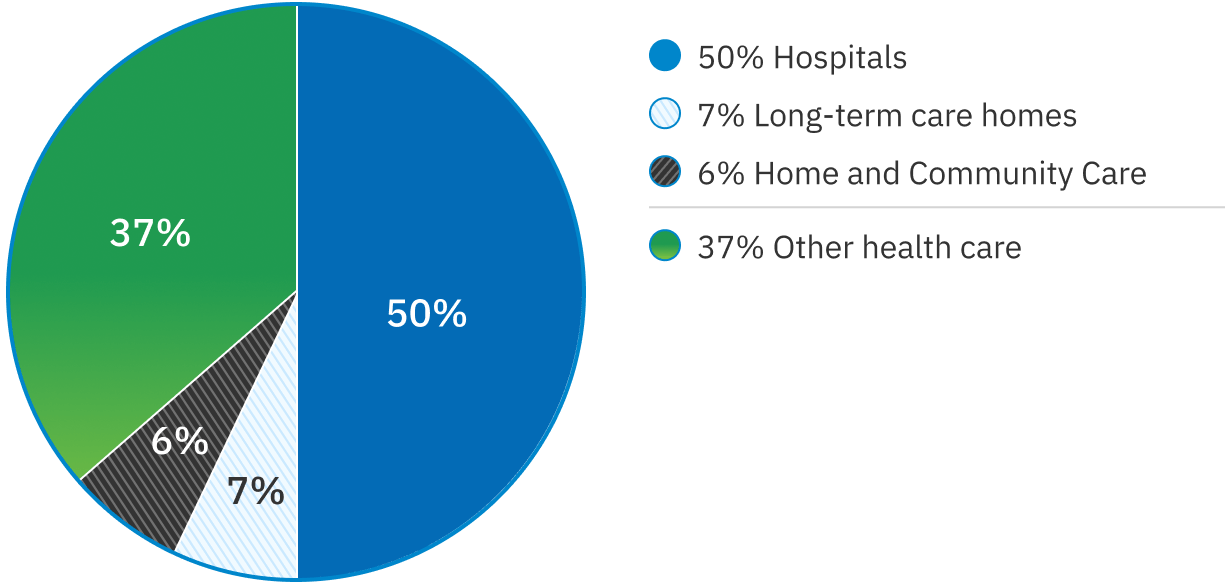
Complaints by sector
Public hospitals: 50% of complaints
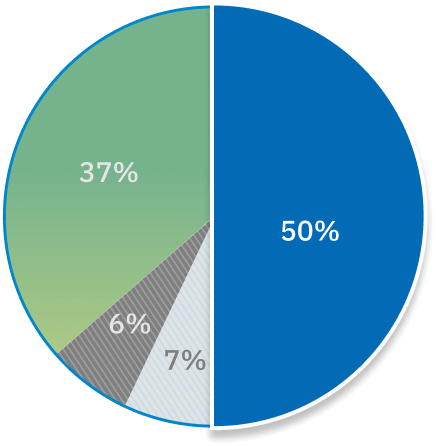
While the overall number of complaints about hospitals increased by 13%, they made up a smaller percentage of the total complaints in 2022/23.
Top complaints
- # 1 Quality of care : 17%
- # 2 Diagnosis/treatment : 16%
- # 3 Discharge/transfers/transition : 12%
- # 4 Communication : 9%
- # 5 Sensitivity/caring/courtesy/respect : 8%
Complaints frequently involved more than one subject
Fifty per cent of the complaints within Patient Ombudsman’s jurisdiction involved public hospitals (2,264). This is not surprising since significantly more people receive care from hospitals than from the other health sector organizations.
As in prior years, concerns about quality of care, diagnosis/treatment and discharge or transfer were the top three complaints about hospitals. In 2022/23 complaints about communication and lack of sensitive, respectful care rounded out the top five concerns. These issues are explored further in a follow-up discussion later in the report that examines concerns about care in hospital emergency departments.
Long-term care homes: 7% of complaints
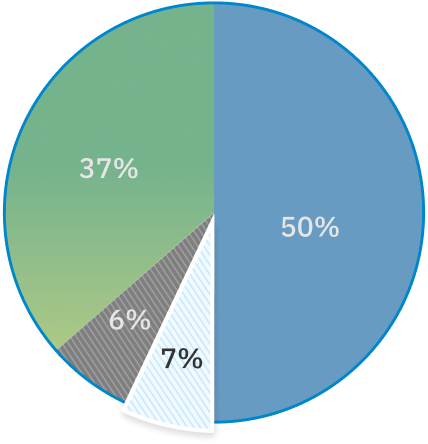
While the overall number of complaints about long-term care homes increased by 2%, they made up a smaller percentage of the total complaints in 2022/23.
Top complaints
- # 1 Quality of care : 23%
- # 2 Visitation/support person : 12%
- # 3 Personal security/safety : 10%
- # 4 Communication : 7%
- # 5 Alleged abuse/assault : 6%
Complaints frequently involved more than one subject
Seven per cent (334) of complaints involved long-term care homes in 2022/23, significantly lower than the 858 complaints received about long-term care homes in 2020/21, the first year of the COVID-19 pandemic. The easing of restrictions on visiting, widespread COVID-19 vaccination, and government investments in staffing and infection prevention and control likely contributed to the return to pre-pandemic levels of complaints.
Complaints about visitation continued to be a top five concern in 2022/23, however, there was a smaller number of complaints in 2022/23 and the nature of the complaints was more specifically focused on policies related to vaccination and masking requirements.
Home and Community Care Support services: 6% of complaints
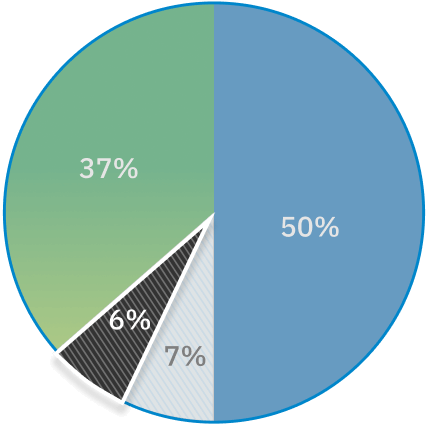
While the overall number of complaints about home and community care support increased by 17%, they made up a smaller percentage of the total complaints in 2022/23.
Top complaints
- # 1 Staffing/resources/services : 18%
- # 2 Access or admission : 18%
- # 3 Coordination/continuity : 18%
- # 4 Quality of care : 14%
- # 5 Communication : 9%
Complaints frequently involved more than one subject
The smallest group of complaints involved home and community care at 6% (272). This includes 167 complaints about Home and Community Care Support Services organizations and 12 complaints about other home and community care organizations that came under Patient Ombudsman’s jurisdiction in September 2022.
Despite efforts by the health care sector and government aimed at improving training opportunities, recruitment and retention of personal support workers, the complaints reflected ongoing challenges with staffing and stability of personal support services for home care patients. While most of the concerns were about challenges with care at home, 38 involved the Home and Community Care Support Services organizations’ responsibility for coordinating long-term care home placement. An additional 77 complaints about hospitals reflected concerns with long-term care home placement but did not include Home and Community Care Support Services in the complaint.
Other: 37% of complaints
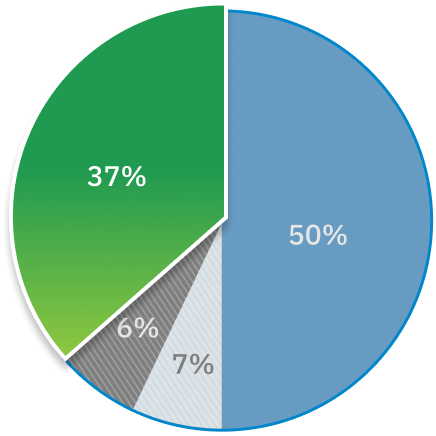
The number of complaints that fall under "Other" nearly doubled in 2022/23 and represents a much larger proportion of total complaints compared to 2021/22.
Most frequent out-of-jurisdiction programs and services included in 2022/23 complaints
- # 1 Medical care/medical practices : 1,081
- Primary care : 785
- Specialist care : 243
- Unspecified : 53
-
#
2
Ministry of Health
(Ontario Health Insurance Plan (OHIP),
drugs and devices) : 76 -
Ministry of Long-Term Care
(Action line and Inspections Program) : 24 - # 3 Programs/services funded by other ministries : 69
- # 4 Ontario Health-funded community services : 42
- # 5 Private hospitals/independent health facilities : 39
Thirty-seven percent (1,648) of complaints involved concerns about services and organizations that are outside of Patient Ombudsman’s jurisdiction, more than the number of complaints about long-term care and home and community care combined.
The number of non-jurisdictional programs and services included in 2022/23 complaints were almost double the number received in 2021/22. Some complaints identified multiple non-jurisdictional organizations, services or programs.
Hospitals: 61% of complaints
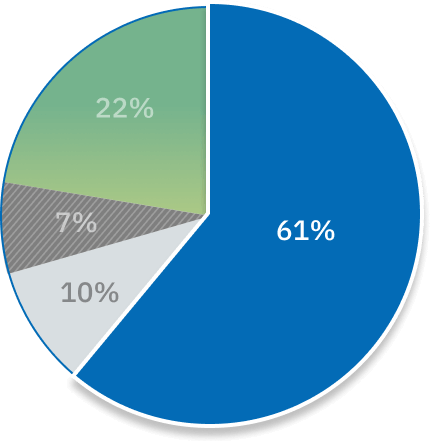
Top complaints
- # 1 Quality of care : 17%
- # 2 Diagnosis/Treatment : 13%
- # 3 Discharge/Transfer/Transition : 11%
- # 4 Visitation : 10%
- # 5 Access or delay : 8%
Long-term care homes: 10% of complaints
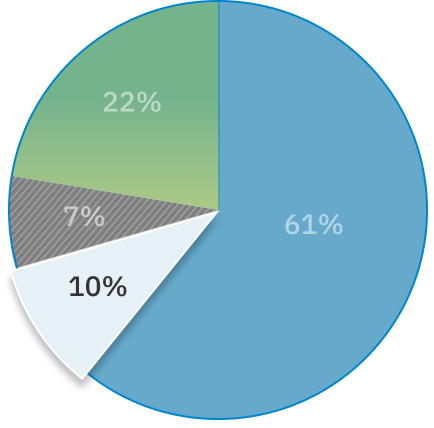
Top complaints
- # 1 Quality of care : 24%
- # 2 Visitation : 19%
- # 3 Communication : 12%
-
#
4
Personal security/
safety : 6% - # 5 Finance/cost : 6%
Home and Community Care: 7% of complaints
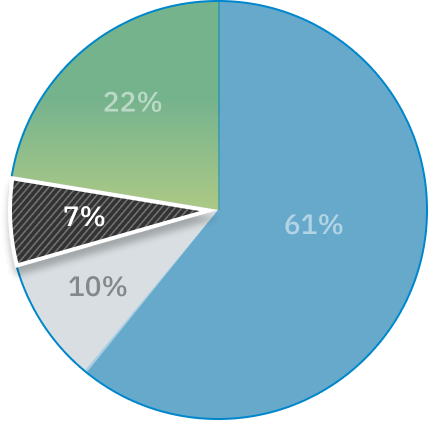
Top complaints
- # 1 Access or delay : 25%
- # 2 Staffing/resources : 20%
- # 3 Coordination/continuity of care : 16%
- # 4 Quality of care : 12%
- # 5 Communication : 10%
Other: 22% of complaints
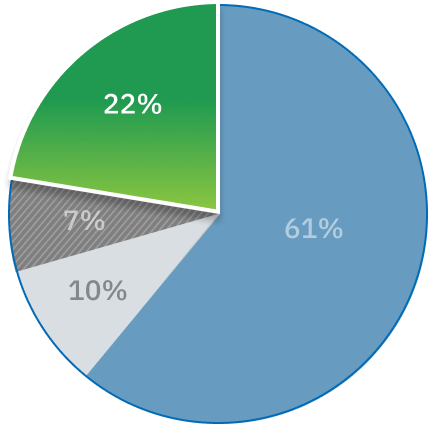
More than 20% of complaints involved health services that are outside of Patient Ombudsman’s defined jurisdiction. Some of these complaints could be referred to a regulatory college or other complaints body that had jurisdiction over the issues described.
Complaints outside Patient Ombudsman’s jurisdiction
Helping people navigate
When complaints or parts of complaints fall outside of Patient Ombudsman’s jurisdiction, the early resolution team helps people connect with the appropriate oversight organization or support service.
We offered more than 2,600 referrals to patients, residents and caregivers in 2022/23 to help them fully address their concerns. In addition, 1,584 people were referred to patient relations representatives at health sector organizations to ensure that their health sector organization had the opportunity to address their concern before Patient Ombudsman became involved. We made 21 mandatory reports to the Ministry of Long-Term Care Inspections Branch about serious complaints about long-term care homes that involved harm or risk of harm to residents as required under the provisions in the Fixing Long-Term Care Act, 2021.
A growing number of complaints touch on situations that not only fall outside of Patient Ombudsman’s jurisdiction but have no appropriate oversight or referral mechanism. Going forward, our office will start analyzing the data collected to better understand this unaddressed need.
When patients, residents and caregivers identify a need for assistance to help deal with distress, health care issues or other concerns, Patient Ombudsman tries to help. More than 300 referrals were made to distress centres or emergency health services to help people in crisis, as well as to health care, legal or other types of services.
Complaint decisions in 2022/23
The path to resolutions
Patient Ombudsman closed 4,528 complaints in 2022/23 including 440 complaints carried over from 2021/22.
This represents a 38% increase in the number of files closed in 2022/23 compared with the previous year. The increase in case closures is due to increased staffing and focused efforts to eliminate a backlog created by a surge in complaints during the COVID-19 pandemic. To ensure timely complaint management going forward, the office has implemented process improvements including a rigorous triage process that prioritizes those currently receiving care and safety concerns, and improved communication throughout the resolution process.
Results achieved through the resolution process
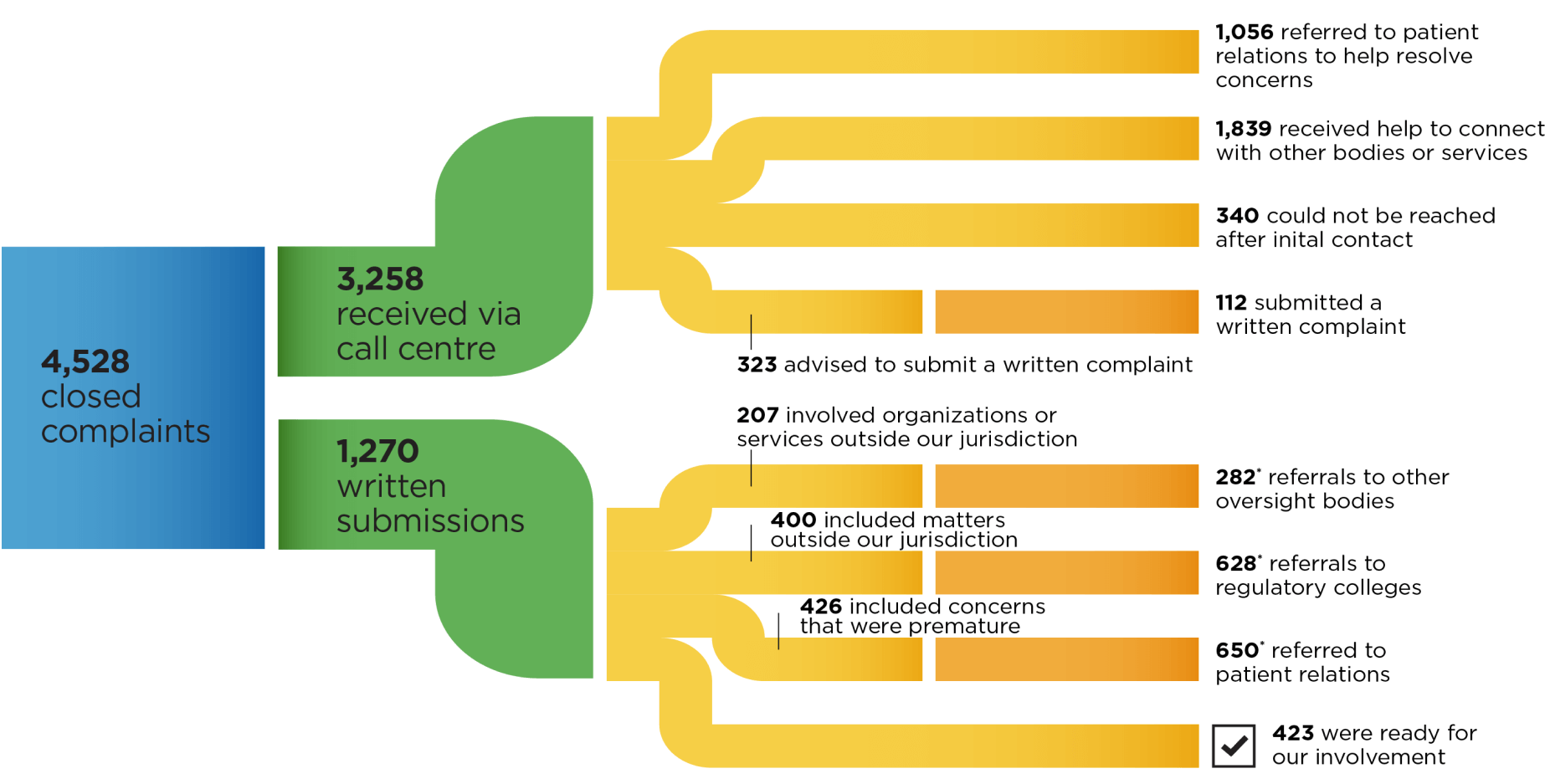

*Some resolutions resulted in multiple referrals.
Actions taken and outcomes achieved by Patient Ombudsman
Actions taken to understand the circumstances
Depending on the nature of the complaint, Patient Ombudsman’s team may take a range of actions to fully understand the circumstances and the options to resolve a person’s concerns.
- requesting and reviewing records, including policies and procedures or health records;
- facilitating or participating in meetings or case conferences;
- researching options and potential solutions;
- making suggestions to health sector organizations; and
- providing information and explanations.
Outcomes
Patient Ombudsman’s team works with complainants to understand the outcome they are seeking and determine if it is achievable. It’s not unusual for complainants to simply want their negative experience understood and acknowledged by the health sector organization to help ensure that others don’t have similar experiences. Other times, complainants want Patient Ombudsman to be aware of a systemic issue that the health sector organization cannot address on its own.
- formal apologies;
- services provided;
- revisions to policies, procedures and forms;
- staff education and training; and
- fees adjusted or waived.
Patient Ombudsman’s focus is on fairness and sometimes, after reviewing a complaint, we may determine that a health sector organization has already fairly addressed the concern. In these cases, Patient Ombudsman provides an explanation or information about the health sector organization’s response and why we deemed it to be fair.
Investigations
Deeper insights for system change
Our investigation summaries raise awareness on important issues and specific circumstances negatively impacting health care experiences in Ontario. They also serve as catalysts for systemic change and help other organizations facing similar challenges.
Each health sector organization involved in a complaint receives a full investigation report and recommendations; investigation summaries are published on our website.
The investigations team completed three complaint-based investigations in 2022/23 that examined:
Billing for uninsured services
Patient Ombudsman investigated a cluster of complaints about a hospital’s billing processes related to uninsured patients and services.
Investigation
Billing for uninsured services
Why this matters
Informed choice is one of the cornerstones of ensuring a fair process. When hospitals charge patients for services where the patient had no choice, charge patients who are admitted involuntarily, do not explain their forms or policies clearly, then patients are at a distinct disadvantage. Ensuring clarity in policies and procedures helps protect patients from unnecessary charges and ensures they understand their financial obligations.
Resources on this issue
Patient Ombudsman made eight recommendations based on the findings of the investigation aimed at ensuring that the administrative processes related to billing are fair, transparent and consistent with government policy and legislation. The recommendations also address the hospital’s response to patient or caregivers concerns about charges, including the process for escalating unpaid bills to collection agencies and improving the collaboration between patient relations and the hospital’s finance department.
View recommendations documentPatient Ombudsman investigated a cluster of complaints about a hospital’s billing processes related to uninsured patients and services. The concerns described in the complaints included:
- charging an uninsured patient admitted involuntarily under the Mental Health Act for hospital care;
- charging patients for uninsured services despite patients reporting that they did not understand or were unable to read the forms they were being asked to sign;
- billing for preferred accommodation when only semi-private or private beds were available;
- billing for preferred accommodations after a patient had made a request to cancel their choice for preferred accommodations; and
- invoices that did not describe the reason for charges or contained incorrect information.
A full list of the recommendations is available on the Patient Ombudsman’s website at: Investigation Summary: Billing for uninsured services.
Chronic care co-payment
Patient Ombudsman investigated a complaint that a patient had been inappropriately charged the chronic care co-payment.
Investigation
Chronic care co-payment
Why this matters
When working to resolve complaints, Patient Ombudsman looks at what was decided, how it was decided, and how people were treated. When decisions are made in an arbitrary manner or are not consistent across a health system or from location to location, it creates an imbalance of access to care. Ensuring fair billing for all patients and reimbursing patients who were incorrectly billed for services ensures the fair provision of care.
Resources on this issue
Patient Ombudsman made seven recommendations to the hospital based on the findings of the investigation aimed at ensuring the chronic co-payment is charged fairly and consistent with provincial legislation and policy, and that communication is clear and transparent. A single recommendation was made to the Home and Community Care Support Services organization to ensure that the crisis designation is being monitored and applied fairly in accordance with regulations.
View recommendations documentPatient Ombudsman investigated a complaint that a patient had been inappropriately charged the chronic care co-payment. The co-payment can be charged to patients who have been deemed to be more or less a permanent resident of the hospital while awaiting placement in complex continuing care bed or long-term care home. In this case, hospital staff facilitated the patient’s assessment for long-term care and suggested the patient apply to a short-term assisted living program in the community to wait for placement. The family was told that the patient would be placed on the “crisis” list for placement if they moved to the assisted living program, which would likely shorten the wait time for a long-term care bed. The hospital billed the patient the chronic co-payment even though short-term assisted living programs are community placements. The Ministry of Health guidelines do not consider community placements as meeting the requirements to charge the chronic care co-payment.
A full list of the recommendations is available on the Patient Ombudsman’s website at: Investigation Summary: Chronic care co-payment.
Reprisal and access to care
Patient Ombudsman received a complaint from a patient expressing concerns that a hospital’s patient relations process had damaged their relationship with their specialist physician resulting in the termination of the patient-physician relationship.
Investigation
Reprisal and access to care
Why this matters
Patients should be able to make complaints about their care without fear of losing access to care. Complaints allow the health care system to learn and improve, and ensure that a negative experience doesn’t happen to someone else.
Resources on this issue
The investigation resulted in four recommendations for improvements in the hospital’s patient relations policies and practices, including an explicit statement in policy that patients and caregivers should be able to complain about hospital staff and physicians without fear of reprisal. The recommendations also addressed the need for the hospital to ensure that physicians are aware of the hospital’s expectations and consider strategies to address barriers to hospital care that may arise due to policies in physicians’ community practices.
View recommendations documentPatient Ombudsman received a complaint from a patient expressing concerns that a hospital’s patient relations process had damaged their relationship with their specialist physician resulting in the termination of the patient-physician relationship. The patient reported that they were now unable to access outpatient specialist care at the hospital.
A full list of the recommendations is available on the Patient Ombudsman’s website at: Investigation Summary: Reprisal and access to care.
Update on Patient Ombudsman Own Motion Investigation
In June 2020, Patient Ombudsman launched a systemic investigation into the experiences of residents and caregivers in selected long-term care homes that managed a COVID-19 outbreak in the first wave of the pandemic. One of the long-term care homes challenged Patient Ombudsman’s authority to conduct an own motion investigation given that there were other proceedings already reviewing the impact the pandemic had on long-term care. In November 2022, the divisional court found in favour of the home.
Patient Ombudsman is concerned that the divisional court’s decision creates significant barriers to Patient Ombudsman commencing own motion investigations. As such, Patient Ombudsman is moving forward with an appeal of the decision, while also seeking changes to the Excellent Care for All Act, 2010 that would clarify Patient Ombudsman’s authority.
The office is reviewing the ways in which we may be able to share valuable findings from our work into long-term care complaints due to COVID-19.
Spotlight issues
Lessons We Can Learn
Patient Ombudsman monitors the complaints we receive to identify emerging issues. Our “Spotlight” stories shine a light on the kinds of cases we receive, how we achieve resolutions, and where health sector organizations can look for opportunities to improve patient and caregiver experiences.


